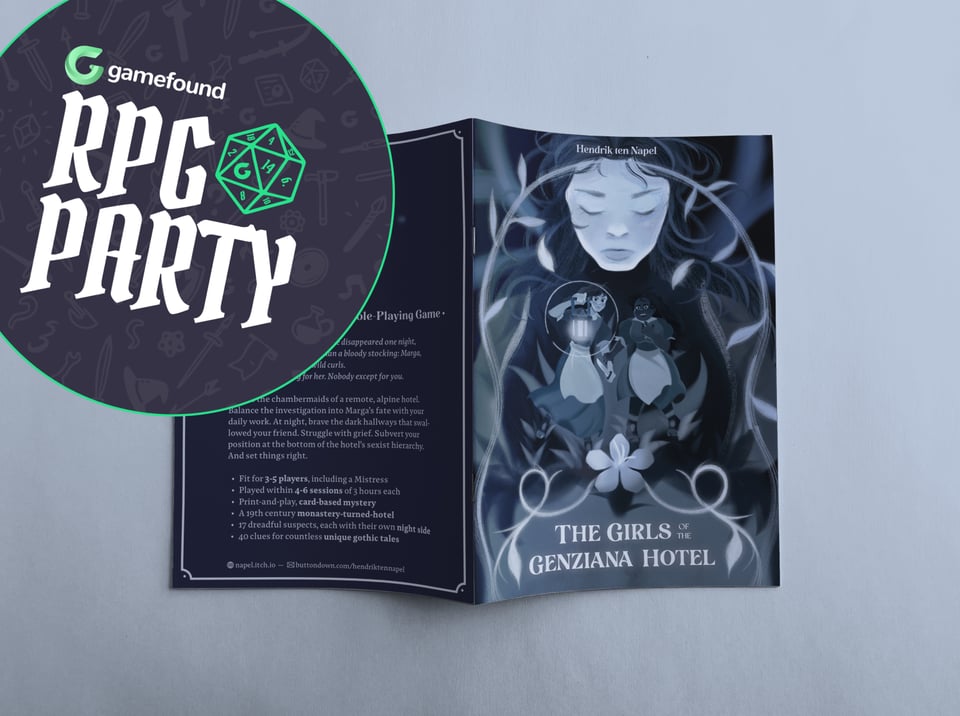Game mechanics as demands, refusals, requests, encouragements, discouragements and allowances

My brother texted me,
and said: ‘Is it common in rpg discussions to look at rules as affordances?’ That might sound odd or surprising to you—or just plain esoteric—but I know that my brother is, among other things, a philosopher and mathematician, so while I was immediately interested, I wasn’t exactly surprised.
Anyway, I told him that I had never seen anyone do that in my, admittedly, brief tenure as a designer and blogger.1 From the Wikipedia screenshots he had added to his text I could see that he was onto something though. So as the designer brother of the pair, I took it upon myself to see if I could make something of his intuition. Spoiler: I think affordances are a great tool for analyzing the role mechanics play within the design of a role-playing game.
Affordances? What are those?
So what do we mean by ‘affordance’? Well, it’s a concept used in a lot of different fields of study, chief among them ecology and technology studies. In a seminal article from 2017, Jenny Davis and James Chouinard give this definition:2
Broadly, affordance refers to the range of functions and constraints that an object provides for, and places upon, structurally situated subjects.
Put slightly less academically, looking at an object through the lens of affordance, you give special attention to the uses or limits it offers to users. Here’s two examples. A stool provides us with a surface to sit on, but also offers us one to stand on—maybe unsafely, if it’s a wobbly stool. A chair does the same, but also offers a back to lean against. In contrast, a speed bump affords us something a little different: a limit to how fast we can comfortably drive over it, or an unwieldy way to damage our car’s exhaust pipe.
If you think that’s a little broad or vague, you’re not alone. Davis and Chouinard say the concept has a history of ‘overuse, misuse, and varied uses’. That is why they propose to stop writing about what an affordance is, and start writing about how they work. And it’s that framework I want to apply to role-playing games in this article.
How do role-playing games afford?
Davis and Chouinard say an object enables or constrains—that is, affords—in degrees. To get a handle on those degrees, the researchers offer what they call ‘a suite’ of ‘analytic pegs’. Basically, they’ve conceptualized six categories of affordance: demand, refuse, request, encourage, discourage, and allow.3 For example, cattle grids allow a lot of people to pass, but refuse passage to the cows that might be following them. Stairs don’t just afford us a way to climb, but might allow for an easy climb if they’re built well.
So while a role-playing game can’t make you do anything—I’ll get back to that in a minute—its rules and mechanics might demand you to follow a procedure to start the game, allow you to decide the gender of your character, or encourage you to spend your resources to better your chances when rolling the dice.
More generally, looking at games as technologies that afford us certain functions and constraints furnishes us with a shared language to analyze their parts and how they relate to us as players. So let’s dig a little deeper so I can show you how that would look.
Demand
‘An artifact demands when its use is conditioned on a particular set of circumstances.’ Most cars demand the turn of an ignition key to start. It won’t start otherwise. ‘Mobile phones that are “locked”,’ write Davis and Chouinard, ‘demand that users remain with a particular service provider.’ It won’t have a signal otherwise. In this way, demands are often linked to certain refusals, but not necessarily. Case in point: role-playing games.
Games certainly make demands. Just look at the moves in Apocalypse World. ‘Read a Sitch’, for example: ‘When you read a charged situation, roll+sharp.’ When a player describes their character taking the temperature of an angry mob, the game demands them to pick up the dice. Wanderhome describes its setting like this: ‘The Hærthland was recently caught in a war, but is no longer. There is no violence here anymore.’ Taken seriously, I would say the game demands its players to abstain from describing violence.4 A lot of rules are demands, I think—notice I say rules here, not mechanics.

‘But role-playing games can’t make you do anything!’ Just like you don’t have to use your car to get somewhere, you might decide to play a game while ignoring one of its rules. The game cannot coerce you, but that doesn’t mean a game cannot make a demand of you. A game can’t refuse you as readily as your car’s ignition can, that’s true. But that just means its demands are easier to rebuff than it is to hot-wire your car. A lot easier, really. A game will only start to refuse once you ignore enough of its demands, and probably only because you’re not really playing it anymore.
Demands place active limits on players’ behavior, and often, in that way, shape how their shared make-believe develops at the table. The demand to roll the dice ‘when you do something risky’ in Lasers & Feelings takes the result of that risky action out of the players’ hands. The demand that you ‘spend a token’ when you want to ‘get out of harm’s way’ in Dream Askew shapes your storytelling through a limited resource.
Refuse
A role-playing game’s demands don’t often translate into a corresponding refusal, but that doesn’t mean that games can’t refuse you. A mystery module for Brindlewood Bay, for example, refuses to tell the GM who’s responsible for the murder that the players are tasked to solve. ‘There are no canonical solutions to Brindlewood Bay mysteries,’ says the game, ‘the solution is whatever the players come up with at the table’—facilitated by a certain game mechanic, as some of you will know.
More commonly, many games refuse to tell you the gender of the character you’ll play. Instead the game might demand or request you to decide for yourself. Sleepaway specifically demands that players ‘describe’ their gender, because it ‘doesn’t care whether you’re cis, trans, or something more tangled.’ In other words, it refuses recourse to conventional gender concepts. Instead, the game offers options such as ‘Health Goth’, ‘Wonder Woman’ or ‘Grasslad’.
“By refusing expectations, role-playing games can purposefully create blanks and openings”
Not all refusals will be explicit, but as long as a game makes something pointedly unavailable, the concept applies. Thirsty Sword Lesbians is about lesbian characters that lust after one another, but it refuses to tell you what the setting of that story will be. ‘What matters are the feelings and relationships between the characters, and those can occur in a wide range of settings,’ it says instead, softly encouraging you to think about a setting you’d be enthusiastic about yourself.
In the examples here, all the refusals are about expectations: of genre, of identity, or even of games in general. By refusing those expectations, role-playing games can purposefully create blanks and openings that benefit their design and themes.
Request
Because of their relation to demands, requests are an interesting category in the context of role-playing games. Here’s how Davis and Chouinard introduce them: ‘requests invite subjects to engage the object in a particular way, evoking particular outcomes over others.’ A speed bump makes slowing down attractive but doesn’t make it impossible for you to go full speed ahead.
I would say that Blades in the Dark only requests that you don’t plan out the details of a heist before you start to play it out. Some might say the game demands it, and while I agree Blades works best that way, the text just doesn’t go as far as that:
You, the players, don’t have to do the nitty-gritty planning. … All you have to do is choose what type of plan the characters have already made. There’s no need to sweat all the little details and try to cover every eventuality ahead of time, because the engagement roll ultimately determines how much trouble you’re in when the plan is put in motion.
The mechanics point towards a loosely sketched out plan, but other approaches are not made impossible (as far as a game can do that). You don’t have to plan, and the engagement roll works against planning, but Blades never makes a clear demand.
Not convinced? Take a look at Blades ‘68, Tim Denee’s sequel to Blades in the Dark. Blades ‘68 provides a strict procedure for planning: ‘Crew business begins with the planning meeting, where the crew regroups to plan their next score. Follow the steps below.’ These steps demand players to generate options for their next score in a specific way and choose one of them. You can only skip the planning meeting if ‘it’s obvious what the next score will be’ or if ‘you stumble into a score’.5
A more or less implicit request that a lot of games make is campaign play over oneshots. The Warren, for example, might say it’s ‘designed to play well in a single chapter’—which is true—but when it comes to explaining how chapters work, it says the game ‘is broken up into a series of chapters’. It then details a procedure for creating a world for that story to take place in. Following that procedure, players will develop a pretty hefty setting, not a quick scenario for a oneshot. So how does The Warren really request to be used?
Encourage
In Brindlewood Bay, the players decide who the murderer is. That is, if the dice go their way. After the players have collected a certain amount of clues, they can try and formulate a theory. The game encourages them to connect as many clues as they can (or explain them away convincingly), and it does so by rewarding them with better chances on their dice roll. The more clues they connect, the more likely it becomes that they’ll roll a success and confirm their theory as the truth. ‘Artifacts encourage when they foster, breed, and nourish some line of action,’ is how Davis and Chouinard put it.

Modifiers—a +2 in Strength, a +3 in Dexterity—have such an encouraging effect. Or take Blades in the Dark’s action ratings. There are twelve Actions in that game, and each character has a different amount of points spread between them. Each point adds a die to your pool when you roll to see how well you perform that action. Confronted with an obstacle or a threat, you look down and see this spread of ratings. Don’t they encourage you to find a way to make the best of your three points in Wreck instead of your one point in Prowl?
Here’s something I struggled with: examples of play. In Slugblaster’s five page long ‘Demo’, for instance, there’s a lot going on. There’s a moment when the GM decides a certain action is ‘still mundane enough to not need a roll.’ Then, a little further along, a player negates a consequence—’boiling acid face’—marking one of their character’s resources. Throughout the example, though, the players also make jokes, reference movies, chip in with ideas, and even get a little too rowdy to continue play for a minute. Does the example encourage you to play this way? Do examples of play nourish playstyles? Or are they simply requests?
Discourage
A ‘line of action’ is discouraged, say Davis and Chouinard, when it is ‘only accessible through concerted effort’. In other words, discouraged outcomes ‘lie behind inbuilt barriers’. They give the example of a ‘“hookup” style’ dating app, that restricts biographical information to a minimum and floods the user with matches, discouraging ‘careful selection of a partner’. A discouragement is a soft refusal, you could say.
In role-playing games, distinguishing encouragements from discouragements is not a binary exercise. AGON, a game about epic heroes, encourages players to resolve scenes together, via a group roll. It is not impossible to go at it alone, but the unpredictable dice mechanics discourage it—you can’t reliably bet on your solitary success. Encouragements tend to come with corresponding discouragements, but it’s useful to try to determine which concept dominates the design.
“Nazi-killing vampire game EAT THE REICH’s ‘Evil Calibration Checklist’ conceptualizes four degrees of evil behaviors”
For example, EAT THE REICH, a hyper-violent game about nazi-killing vampires, comes with an ‘Evil Calibration Checklist’. It conceptualizes four degrees of evil behavior, listing types of brutal and disgusting things that might happen during the game: evil inherent to the setting (like drinking blood), evil that might be a point of conflict between player characters, evil that will happen, but that will not be performed by the player characters, and evil ‘no one does, not even villains’. EAT THE REICH requests the players to go down this list point by point, discussing the contents of each category.
The player’s specific agreements on murdering innocents or magical mind control are demands: they prohibit the players from including those subjects to a specific degree. The procedure as a whole, though, acts as a discouragement. It deters players from narrating uncritically and carelessly going forward, even when they are not touching upon the subjects they’ve explicitly calibrated.
Allow
So far, we’ve seen how games push and pull at players ‘with varying degrees of intensity', to paraphrase Davis and Chouinard. An allowance is more neutral. ‘Artifacts allow by remaining indifferent to if and/or how a particular feature is used, and to what outcome.’ The option to set up an automatic signature for your e-mails is an allowance.
AGON’s character sheet features what looks like the frame of an ancient Greek shield, perfectly round. The space allows you to draw in, well, whatever you like, if you want to. In contrast, CBR+PNK, a sci-fi action game, provides you with the vague outline of a face, encouraging you to draw a character portrait. The Warren does something similar, presenting you with the silhouette of your rabbit protagonist, encouraging you to just add some distinguishing details.

Most games allow you to roll whatever dice you want, but some demand you to roll distinctly colored dice. Trophy Dark, a tragic fantasy game, demands you to roll ‘light’ and ‘dark’ dice, for example. Most games allow you to pick any character class you’d like, although a lot of them discourage the players from choosing the same class. A hex crawl allows the players to choose the direction in which they want to travel, remaining functionally indifferent to the direction they choose.
Thirsty Sword Lesbians’ refusal to detail the setting of the game demands the players to choose a setting themselves. They can either pick one of the examples the game comes with, or design one of their own; Thristy Sword Lesbians allows for both. It does encourage you to construct your own ideas according to a set of setting questions to help you construct it more effectively though.
For whom do role-playing games afford?
Do you remember that part about ‘structurally situated subjects’ in the definition I quoted at the start of this piece? Well, that’s a complicated way of saying that objects don’t afford the same way for everyone. The cattle grid I mentioned earlier might allow most able-bodied persons to pass over it, but it could discourage people that use a walker.
Davis and Chouinard distinguish three ‘conditions of affordance’: perception, dexterity, and cultural and institutional legitimacy. These conditions are, I would say, less aptly named than their categories of affordance, especially if we’d like to apply them to role-playing games. Conceptually though, they are as interesting as the rest of the framework.
Here’s how they explain them:
Conditions of affordance vary with subjects’ awareness of the function (perception), their skill and ability to execute the function (dexterity), and social support in executing the function (cultural and institutional legitimacy).
People each bring their own situation to an object. Part of it might be physical, like color blindness. Part of it might be institutional, like the way your passport allows you to travel. In the same way, players bring their own situation to the role-playing games they’ve picked up.
Awareness
To reiterate: for a game to afford you something, you have to be aware of what it’s affording you, you have the knowledge and ability to make use of those affordances, and you have to believe you’re supposed to use them, in other words, have cultural and institutional access to them. But that’s all pretty abstract, let’s look at some examples.
If a game’s rules are spread throughout the rulebook and badly indexed, players could simply remain unaware of certain affordances the game is trying to provide them with. Similarly, misconstruing a rule provides the player with the awareness of an unintended affordance. For example: since it’s put forward as part of a prosaic description of the game’s setting, Wanderhome’s demand for a non-violent setting could be read as poetic hyperbole. Read that way, it would afford differently: it might be taken as a request instead, or another, more ambiguous demand.6
“Wanderhome’s demand for a non-violent setting could be read as poetic hyperbole”
On a more general level, since role-playing games are, mostly, produced in the form of books, a well-produced digital version may be a condition for some people to even absorb a game’s text. They may rely on text-to-speech apps if they have trouble reading, for example. Games that have digital versions that have been made compatible with those applications will allow them to actually perceive what a game affords them.
Ability
Once you’ve become aware of a game’s affordances, you need to be in a position to make use of them. Qua physical ability, for example. To play Star Crossed, a game that makes use of a jenga tower, you’ll need fine motor skills to remove wooden pieces from the tower without toppling it on your first try. You could be perfectly aware of the game’s demands but lack the ability to meet them.
If you’re used to playing Dungeons & Dragons with a Dungeon Master that talks you through the spells your wizard knows every time you use them, you might be aware of the functions the game affords you without actually knowing how to make use of them yourself. Davis and Chouinard give a similar example: ‘a person might know that unsending e-mail is an option but not have the skill to navigate settings and implement that option.’
Access
Lastly, you might be aware of a game’s affordances, have the ability and knowledge to make use of them, but be culturally or institutionally barred from accessing it. Davis and Chouinard give the example of a woman who believes she’s unequipped to drive because of her gender, even though she has her license. Similarly, a heterosexual player could feel like it’s not their place to portray a queer woman in Thirsty Sword Lesbians, fearing they’re unequipped to do such a character justice.

More generally, a player might avoid certain affordances within a game not because they don’t understand them, but for social reasons. Playing a hero in bronze-age fantasy game Stonetop, someone might bar themselves from persuading a non-player character because they don’t want to encroach on the niche of a character that excels at persuasion, or because they fear to get the party in trouble by rolling a failure.
Itch.io’s recent delisting of NSFW-tagged games is a potent example of how institutional legitimacy influences access. That is to say, by making it impossible to find those games through the website’s search function, itch.io put a big speedbump in the way of potential players looking not just for NSFW-tagged games, but games with explicitly queer theming as well.
Use these tools
‘Clear and flexible analytic tools are essential for deconstructing how technologies—new and old—operate in practice,’ write Davis and Chouinard in the conclusion of their article. ‘Designers,’ they continue, ‘can employ the model to consider how features will prompt and dissuade, for whom, and under what circumstances.’
I think critics and designers of role-playing games would benefit from using these tools too. That’s why I’ve taken the time to showcase how those analyses might look, but I encourage you to read Davis and Chouinards lucid explanation of their ideas for yourself as well.
But before you go, let me leave you with a couple of questions. You might be familiar with games that come with player principles, like Blades in the Dark or Monsterhearts 2. What do they afford players, and how? A lot of games now encourage players to use safety tools. Do you feel like encouragement is enough? Or should games demand their inclusion? Why not?
That’s it for now,
Hendrik ten Napel
PS, my gothic horror mystery rpg is coming to Gamefound.

Reserve your room in the Genziana Hotel today.
When I went looking, I found one very short reddit thread and a couple of articles about affordances in video game design. ↩
Theorizing Affordances: From Request to Refuse, by Jenny L. Davis and James B. Chouinard. ↩
These categories are, like most categories, not exhaustive, but you’d be surprised how much mileage you can get out of them. ↩
Experienced players will know there is one exception, the Veteran, who ‘can always’ unsheathe their blade and ‘immediately kill’ the person in front of them, at the cost of being expelled from the game. This is, I would say, one of those exceptions that proves the rule (and thus, the demand). ↩
I quote the 0.6.3 playtest draft here, since that’s what I have access to right now. ↩
Seeing as author Jay Dragon plays Wanderhome by pushing ‘things up to the brink of violence’ and to then ‘work together to see how we can get out without the situation becoming violent’, the tiny ambiguity I’m pointing at here could even be said to encourage exactly that type of play. ↩